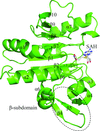issue contents
August 2017 issue

Cover illustration: Combatting antibiotic resistance. The role of conserved surface hydrophobic residues in the carbapenemase activity of the class D ![[beta]](/logos/entities/beta_rmgif.gif) -lactamases (Smith et al., p. 692).
-lactamases (Smith et al., p. 692).
topical reviews
Open  access
access
 access
accessThis paper reviews the recent advances in computational template-based structural modelling and proposes the subclustering of protein domain superfamilies to guide the template-selection process.
research papers
The effect of ion swapping on the activity of an Arenaviridae exonuclease is reported.
The nucleoprotein of Toscana virus forms mainly open fivefold oligomers consistent with the encapsidation mechanism of phlebovirus RNA both in solution and under physiological conditions.
PDB reference: Toscana virus nucleoprotein, 5fva
Hydroxycitrate was co-crystallized with the amino-terminal portion of human ATP-citrate lyase in order to learn how this competitive inhibitor binds. Crystals diffracting to high resolution were obtained by adding cleavage sites in the protein to remove a disordered linker. This strategy could be useful for other proteins that do not crystallize well.
PDB references: human ATP citrate lyase, TEV-cleaved, bound to citrate, 5tde; bound to 4S-hydroxycitrate and ADP, 5tdf; bound to 4R-hydroxycitrate and ADP, 5tdm; bound to citrate and ADP, 5tes; bound to 4S-hydroxycitrate, 5tet; bound to tartrate and ADP, 5tdz; C20S, C293G mutant, bound to 4R-hydroxycitrate, 5te1; C20S, C293G mutant, bound to citrate, 5teq
An in-depth analysis of the PEG-bound C-terminal SH3 domain of myosin IB from Entamoeba histolytica has been performed, which reveals the mode of ligand recognition and will be helpful in the identification of probable binding partners of E. histolytica myosin IB.
The structure of CheR1 in complex with c-di-GMP-bound MapZ is reported and the complex biochemical process which involves CheR1, MapZ, SAH/SAM and c-di-GMP is revealed.
The crystal structure of the class D carbapenemase OXA-143 from A. baumannii shows that a conserved valine residue on the protein surface controls access of the deacylating water molecule to the active site of the enzyme. Analysis of the structures of other class D carbapenemases implicates movement of juxtaposed surface valine and leucine residues in a universal deacylation mechanism for these enzymes.
PDB reference: OXA-143, 5iy2
Open  access
access
 access
accessThe applicability of the ligand-soaking method in serial femtosecond crystallography has been examined to examine the feasibility of pharmaceutical applications of X-ray free-electron lasers.


 journal menu
journal menu
























